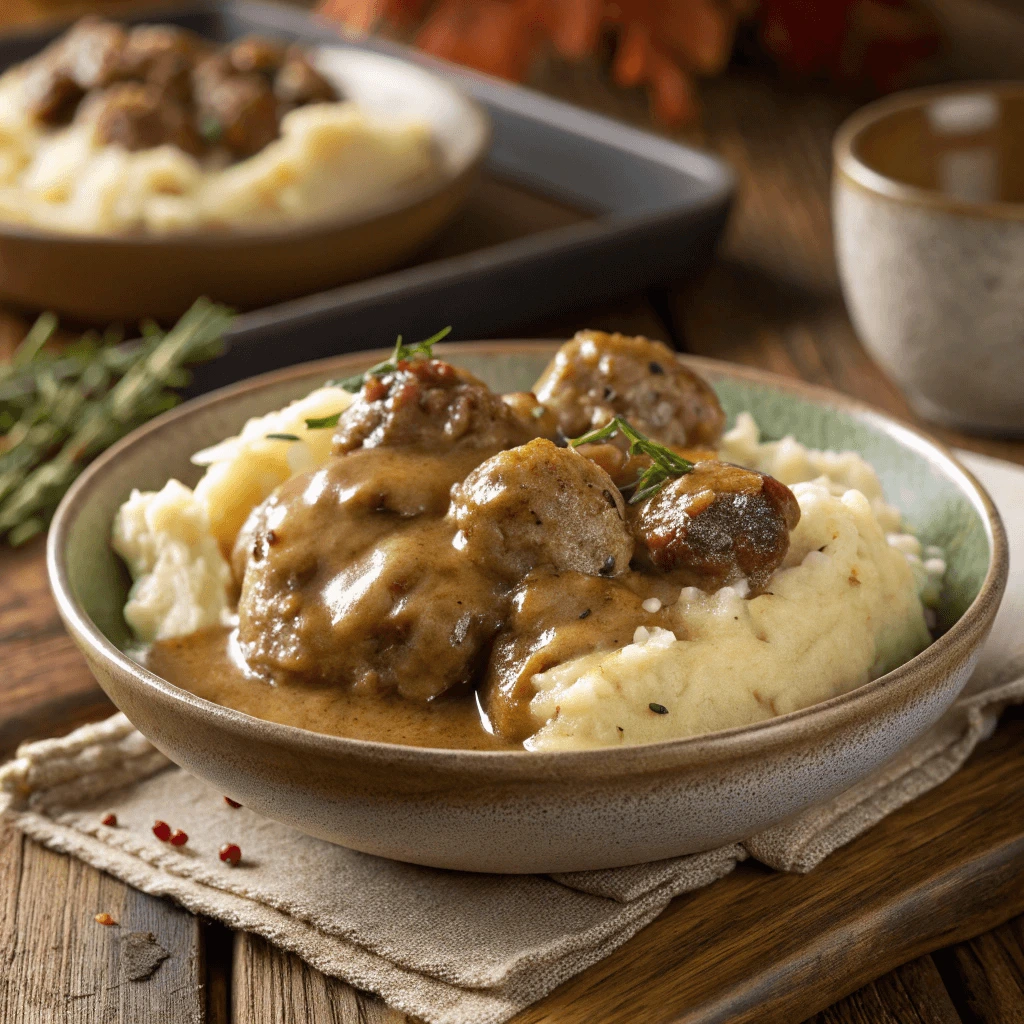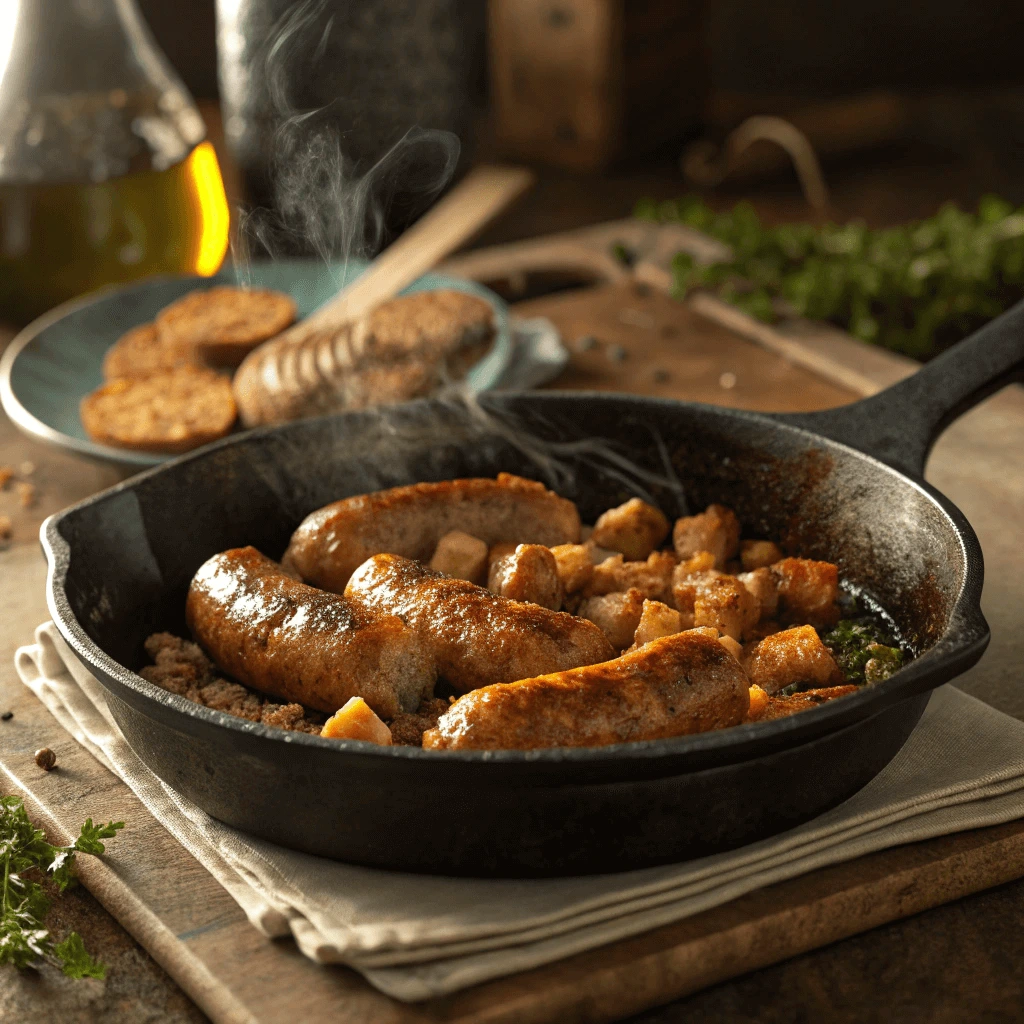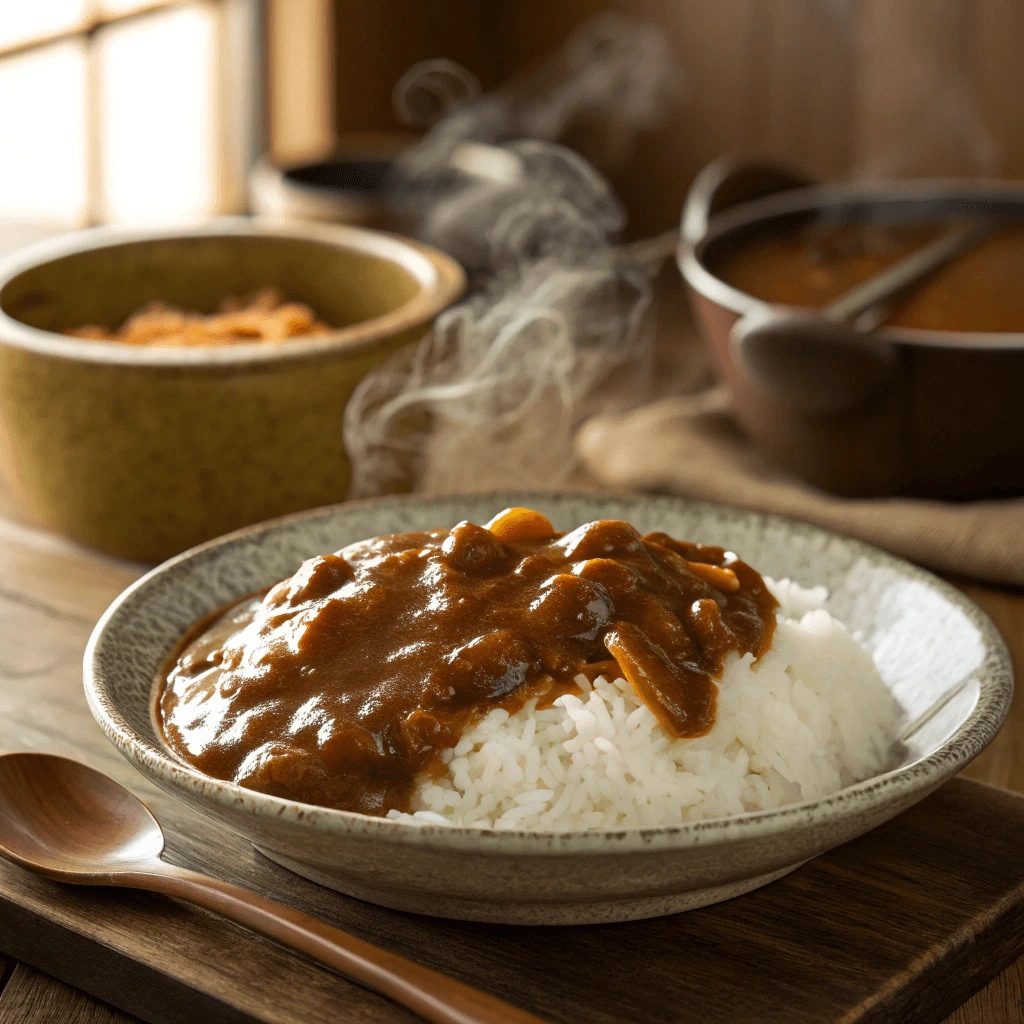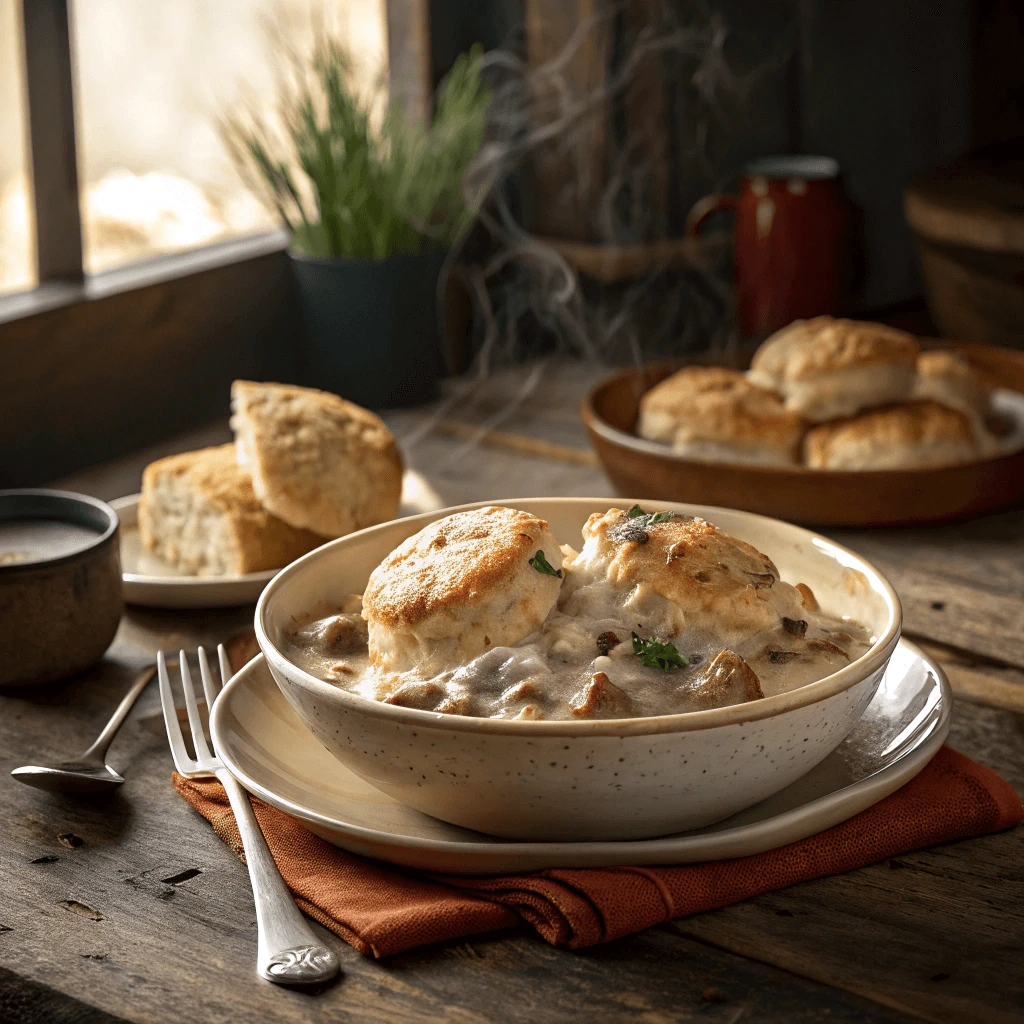Sausage turkey fat gravy is a delicious addition to any meal, and this recipe makes it easier and healthier. By using lean turkey sausage and turkey fat, you get all the savory flavors without the heaviness of traditional gravies. This healthier twist skips pork and bacon, making it a great option for those looking to lighten up their comfort food. You can serve it over mashed potatoes, biscuits, or rice for a tasty dish everyone will enjoy. Plus, it’s quick to make with just a few simple ingredients. Ready to try it? Let’s dive into this easy and flavorful sausage turkey fat gravy recipe!
What Is Sausage Turkey Fat Gravy?

Understanding Turkey Fat and Its Role in Gravy
Turkey fat, often called turkey drippings, plays a key role in creating rich, flavorful gravy. It adds depth and complexity that you can’t get from butter or oil alone.
What Is Turkey Fat?
Turkey fat comes from the drippings left in the pan after roasting a turkey. These drippings include both fat and juices, which are full of flavor. By separating the fat from the juices, you get a perfect base for gravy.
Why It Matters in Gravy
When combined with flour, turkey fat creates a roux—the thickening base of your gravy. This roux not only gives the gravy its smooth texture but also boosts its savory flavor. Unlike butter, turkey fat carries the roasted essence of the bird, making each bite more satisfying.
Extra Flavor, Less Waste
Using turkey fat is a great way to avoid food waste. You can refrigerate or freeze leftover drippings and use them to enhance soups, stews, or roasted vegetables later on.
The Flavor Boost from Sausage in Gravy
Sausage adds richness, texture, and a savory punch that takes turkey fat gravy to the next level. It infuses the dish with layers of flavor that make it stand out—whether you’re serving it over mashed potatoes, biscuits, or stuffing.
Why Sausage Makes a Difference
Sausage isn’t just meat—it’s meat seasoned with herbs, spices, and fat. When you brown sausage in a skillet, those seasonings release into the pan, enhancing every ingredient that follows. The browned bits left behind (called fond) blend into the roux and deepen the gravy’s overall taste.
Choosing the Right Sausage
For this recipe, turkey sausage works best because it pairs naturally with the turkey fat. Choose a variety with balanced seasoning—mild for a subtle flavor or spicy for a kick. If you’re watching your fat intake, lean turkey sausage still delivers excellent taste with fewer calories.
How to Maximize Sausage Flavor
Cook the sausage until it browns and crisps slightly. Don’t rush this step—browning unlocks the full flavor potential. Once cooked, break the sausage into small crumbles and stir them directly into the gravy. Each bite will carry a little extra spice and richness from the sausage.
Traditional vs. Modern Turkey Fat Gravy Recipes
Turkey fat gravy has evolved, offering both classic comfort and modern versatility. Depending on your style and dietary needs, you can choose the version that works best for you.
Traditional Gravy: Simple and Savory
Traditional recipes rely on turkey drippings, flour, and broth. After roasting the turkey, you collect the fat, make a roux with flour, and slowly whisk in the broth. Seasonings like pepper and sage add warmth. This method creates a rich, hearty gravy with deep roasted flavor—ideal for holiday meals.
Modern Gravy: Flexible and Flavorful
Modern recipes add a twist. Many include turkey sausage for extra flavor and texture. Others swap in gluten-free flour or plant-based milk to meet dietary preferences. Tools like fat separators and blenders make prep faster and smoother. The result is lighter, more customizable gravy that still tastes great.
Pick Your Favorite
If you love classic flavor and tradition, go with the old-school version. If you need a quicker or healthier option, the modern method offers plenty of variety without losing the comforting taste of turkey fat gravy.
Ingredients You’ll Need for This Quick and Tasty Gravy
Key Ingredients: Turkey Fat, Sausage, and Flour
The heart of any good sausage turkey fat gravy lies in three core ingredients: flavorful turkey fat, seasoned sausage, and the right flour for a smooth base. Each one plays a specific role in creating the rich taste and creamy texture we love.
Turkey Fat: The Flavor Foundation
Turkey fat adds depth and richness that butter or oil can’t match. After roasting your turkey, collect the golden drippings from the pan. The fat portion carries intense roasted flavor and helps create a silky gravy when blended with flour and broth. For best results, use a fat separator to skim off excess juices and isolate the pure fat.
Sausage: Savory and Bold
Sausage elevates the flavor profile by adding spice, salt, and texture. Choose turkey sausage for a healthier option that still delivers plenty of taste. Brown it well in a pan to release the flavorful oils and create those crispy bits that stick to the skillet. Stirring these into the gravy adds a hearty, meaty punch that makes this dish more satisfying.
Flour: The Thickening Agent
Flour is what gives the gravy its body. All-purpose flour works well, but gluten-free alternatives like rice flour or cornstarch can be used if needed. Combine the flour with turkey fat to create a roux, and cook it for a minute or two to remove any raw taste. This step ensures your gravy thickens properly without becoming lumpy or gritty.
Together, these three ingredients form a well-balanced, comforting gravy that brings every dish to life.
Optional Herbs and Seasonings to Enhance Flavor
While turkey fat and sausage bring bold, savory flavor to the base, a few well-chosen herbs and spices can take your gravy from good to unforgettable. These additions help balance the richness and add layers of aroma and depth.
Classic Herbs That Complement Turkey
Fresh or dried herbs like sage, thyme, and rosemary pair beautifully with poultry-based gravies. Sage adds a warm, earthy flavor that echoes traditional holiday dishes. Thyme brings a subtle herbal brightness without overpowering the gravy. Rosemary, when used sparingly, adds a woodsy aroma that rounds out the flavor profile.
You can stir these herbs directly into the gravy as it simmers, or sauté them briefly in the turkey fat before adding the flour for extra infusion.
Seasonings That Build Depth
Basic spices like black pepper, garlic powder, and onion powder add richness without complicating the recipe. Black pepper gives the gravy a little bite, while garlic and onion powders deliver savory background notes.
A pinch of smoked paprika or a dash of nutmeg can add unexpected warmth and complexity. Just use them in moderation—these stronger spices can quickly overpower more delicate flavors.
Finishing Touches That Brighten the Flavor
Once your gravy thickens, consider finishing it with a splash of fresh lemon juice or a sprinkle of chopped parsley. Lemon juice adds a touch of brightness that cuts through the richness, and parsley gives your dish a fresh, vibrant finish—both in taste and appearance.
These optional additions let you tailor the flavor to suit your meal, whether you’re serving it at a cozy family dinner or a festive holiday feast.
Choosing the Right Broth and Dairy for Creaminess
Getting the right creamy consistency in your sausage turkey fat gravy depends heavily on the broth and dairy you choose. These ingredients don’t just add moisture—they shape the final flavor and texture of your dish.
Pick a Flavorful, Low-Sodium Broth
For the best taste, use turkey broth if available. It complements the fat and sausage naturally. If you don’t have turkey broth, chicken broth is a great alternative that still offers a rich base. Choose low-sodium versions so you can control the salt levels more easily when you season the gravy later.
You can enhance store-bought broth by warming it with herbs like thyme or a bay leaf before adding it to your roux. This extra step adds depth without much extra work.
Choose the Right Creamy Element
Once your gravy base has thickened, you can stir in dairy or dairy-free milk to give it a velvety finish. Whole milk or half-and-half adds light creaminess, while heavy cream creates a richer texture. For a lighter gravy, add a small amount of cream instead of making it the main liquid.
Need a dairy-free option? Try unsweetened oat milk or cashew milk. They’re mild in flavor and offer enough creaminess without changing the taste of the gravy.
Balance Texture with Careful Mixing
Add the broth gradually while whisking the roux to avoid lumps. After it thickens, pour in your dairy slowly, continuing to stir until smooth. If the gravy gets too thick, loosen it with a splash of warm broth or milk. This approach keeps your gravy creamy without turning it runny.
Step-by-Step Guide: How to Make Sausage Turkey Fat Gravy

Preparing the Sausage and Collecting Turkey Drippings
Making a flavorful turkey fat gravy starts with two important steps: cooking the sausage properly and collecting the turkey drippings. These steps add rich flavor and create a delicious base for your gravy.
Cooking the Sausage to Perfection
Begin by heating a skillet over medium heat. Add your turkey sausage, breaking it into small pieces with a spatula. Cook it until it’s nicely browned and cooked through, stirring often. Browning the sausage helps release its natural oils and develops a deep, savory flavor. Once done, remove the sausage from the pan but keep the rendered fat—it will add great taste to your gravy.
Collecting Turkey Drippings
After roasting your turkey, pour the drippings from the roasting pan into a bowl or fat separator. Let the drippings sit for a few minutes so the fat rises to the top. Use a spoon or the separator to scoop off the fat, which you’ll use as the main fat for your gravy. The remaining juices provide flavor and moisture, so keep them handy.
Combining for Flavorful Gravy
Use the turkey fat along with the sausage fat to make your roux—the thickening base for your gravy. Adding the cooked sausage back in boosts the texture and taste. By properly preparing the sausage and collecting the drippings, you create a rich, flavorful gravy that’s sure to impress.
Making the Roux: Combining Fat and Flour Perfectly
A smooth, flavorful gravy starts with a well-made roux. This simple mixture of fat and flour creates the thick, velvety base that binds all your ingredients together. Mastering the roux is essential for perfect sausage turkey fat gravy.
Using the Right Fat
Start by heating the turkey fat you collected from the drippings along with the rendered fat from the cooked sausage. Warm the fat gently over medium heat to melt it fully. The fat not only adds richness but also helps cook the flour evenly, preventing lumps in your gravy.
Adding the Flour Gradually
Sprinkle the all-purpose flour into the hot fat while constantly stirring with a whisk or wooden spoon. Stirring continuously prevents clumps and ensures the flour cooks evenly. Cook the mixture for about 2 to 3 minutes until it turns a light golden color. This step removes the raw flour taste and develops a subtle nutty flavor.
Watching the Color and Texture
Pay close attention to the roux’s color; a pale golden roux works best for turkey gravy because it thickens without darkening the final sauce too much. If you cook it too long or at too high a heat, the roux may burn or become too dark, which can add bitterness.
Ready for the Next Step
Once your roux reaches the right consistency and color, you can slowly whisk in your broth. This gradual mixing keeps your gravy smooth and silky, setting the stage for a rich, flavorful finish.
Simmering and Final Touches for the Best Gravy Texture
After making the roux and adding your broth and dairy, the next step is to simmer your gravy to develop flavor and achieve the perfect texture. This stage requires attention and patience to ensure your sausage turkey fat gravy turns out smooth and delicious.
Gentle Simmering to Thicken
Once you whisk the broth and dairy into the roux, bring the mixture to a gentle simmer over medium-low heat. Avoid boiling, as high heat can cause the gravy to break or become grainy. Simmering allows the flour to fully cook and the flavors to meld together, producing a rich, velvety sauce.
Stir the gravy frequently with a whisk or spoon to prevent it from sticking to the bottom of the pan. Continuous stirring also keeps the texture smooth and free of lumps.
Adjusting Consistency
As the gravy simmers, watch its thickness closely. If it becomes too thick, add small amounts of warm broth or milk gradually until you reach your desired consistency. If it’s too thin, continue simmering and stirring until it thickens naturally.
Remember, gravy will thicken a bit more as it cools, so aim for a slightly looser consistency when you finish cooking.
Final Seasoning and Flavor Boosts
Before serving, taste your gravy and adjust the seasoning. Add salt, pepper, or any optional herbs and spices to enhance the flavor. For an extra touch of richness, consider stirring in a small pat of butter or a splash of cream just before removing the gravy from the heat.
These final touches round out the flavors and create a glossy, appetizing finish.
Healthy Alternatives for Sausage Turkey Fat Gravy

Using Ground Turkey or Chicken Sausage for Lower Fat Content
If you want to enjoy a flavorful sausage turkey fat gravy but prefer a lighter option, swapping traditional sausage with ground turkey or chicken sausage is a smart choice. These alternatives help reduce the fat content while still delivering savory taste.
Why Choose Ground Turkey or Chicken Sausage?
Ground turkey and chicken sausage generally contain less fat than pork or beef sausage, making them ideal for a healthier gravy. They still provide the meaty texture and protein you want, but with fewer calories and saturated fats. This swap works especially well if you’re watching your fat intake or cooking for health-conscious guests.
Tips for Cooking Leaner Sausage
When cooking ground turkey or chicken sausage, use a non-stick skillet or lightly coat your pan with oil to prevent sticking since these meats release less fat. Brown the sausage over medium heat, breaking it into small pieces as it cooks. Keep stirring to ensure even cooking and to develop good color and flavor.
If the sausage dries out, add a splash of broth or a teaspoon of olive oil to keep it moist and flavorful.
Adjusting the Gravy Recipe
Using leaner sausage means your gravy may have less fat to build the roux. To compensate, add a bit of extra turkey fat or a small amount of butter to the pan before stirring in the flour. This step helps create the rich base your gravy needs.
Replacing Flour with Gluten-Free or Whole Wheat Options
If you need to avoid traditional all-purpose flour in your sausage turkey fat gravy, several great alternatives can keep your recipe tasty and thick without compromising texture or flavor.
Choosing Gluten-Free Flour Alternatives
For gluten-free cooking, try using a blend of gluten-free flours like rice flour, tapioca starch, or cornstarch. These options thicken gravy well without adding a gritty texture. Cornstarch is particularly popular because it dissolves quickly and gives a smooth, glossy finish.
When using cornstarch or tapioca starch, mix them with cold water to create a slurry before adding it to the hot fat or broth. This method prevents lumps and ensures even thickening. Keep in mind that gluten-free flours often require less cooking time than traditional flour, so simmer your gravy just long enough to activate the thickener.
Using Whole Wheat Flour for a Healthier Twist
Whole wheat flour works as a nutritious alternative to all-purpose flour. It adds fiber and a slightly nutty flavor to your gravy. However, whole wheat flour has a denser texture, so use it in slightly smaller amounts or mix it with all-purpose flour to avoid a heavy gravy.
To avoid clumping, add whole wheat flour gradually to the hot fat while stirring constantly. Allow the mixture to cook a bit longer than usual to soften the graininess that whole wheat flour can sometimes bring.
Tips for a Smooth and Tasty Gravy
Regardless of your flour choice, whisk the thickening agent continuously when you add it to the fat or liquid. This practice prevents lumps and helps your gravy develop a smooth texture.
Also, taste and adjust your seasoning, since some flour alternatives may slightly alter the flavor profile.
Using Low-Fat Milk or Plant-Based Milk Alternatives
When making sausage turkey fat gravy, the choice of milk or dairy can greatly affect both flavor and texture. Opting for low-fat milk or plant-based alternatives can create a lighter gravy while still maintaining creaminess.
Benefits of Low-Fat Milk
Low-fat milk reduces the overall fat and calorie content of your gravy. It keeps the creamy texture without the heaviness of whole milk or cream. When you add low-fat milk gradually to your roux, whisk constantly to avoid curdling and ensure a smooth sauce.
Using low-fat milk also makes your gravy more suitable for those watching their fat intake, without sacrificing the rich mouthfeel that makes gravy so comforting.
Popular Plant-Based Milk Alternatives
If you prefer dairy-free options, plant-based milks such as almond, oat, soy, or cashew milk work well in gravy. Choose unsweetened and unflavored versions to avoid altering the savory taste.
Oat milk offers a naturally creamy texture that blends seamlessly into gravy. Soy milk provides a neutral flavor and thicker consistency, making it a great substitute. Almond milk is lighter but still adds a subtle nutty note that can complement the sausage flavor.
Tips for Using Plant-Based Milks
Warm the plant-based milk before adding it to the roux to help it combine smoothly. Add it slowly while whisking continuously to prevent lumps. Since some plant milks are thinner than dairy milk, you might need to adjust the quantity or simmer the gravy a bit longer to achieve your desired thickness.
Always taste your gravy near the end of cooking. You may want to tweak seasonings since plant-based milks can slightly change the overall flavor.
Serving Suggestions and Tips for Enjoying Your Turkey Fat Gravy
Classic Pairings: Biscuits, Mashed Potatoes, and More
Sausage turkey fat gravy shines when paired with classic comfort foods. These traditional combinations not only enhance the gravy’s flavor but also create a satisfying meal.
Biscuits: The Perfect Vehicle
Fluffy, buttery biscuits are a timeless match for rich sausage gravy. Their soft texture soaks up the gravy beautifully, making each bite indulgent. Whether you bake them from scratch or use a store-bought version, warm biscuits topped with generous spoonfuls of gravy never disappoint.
Mashed Potatoes: Creamy and Comforting
Mashed potatoes offer a smooth, creamy base that complements the savory depth of the gravy. Use buttery, well-seasoned mashed potatoes to balance the sausage’s bold flavor. Pour the warm gravy over the potatoes just before serving for the best taste and texture.
Other Delicious Pairings
Beyond biscuits and mashed potatoes, gravy pairs well with roasted vegetables, rice, or even stuffing. Drizzling it over roasted green beans or carrots adds moisture and richness to your side dishes. You can also serve it alongside creamy polenta or crusty bread for a hearty, satisfying meal.
Storing and Reheating Leftover Gravy Safely
Properly storing and reheating your sausage turkey fat gravy helps maintain its flavor and texture while keeping it safe to eat. Follow these tips to enjoy your leftovers without any hassle.
Storing Leftover Gravy
Cool your gravy to room temperature within two hours after cooking to prevent bacteria growth. Transfer the gravy into an airtight container or a glass jar with a tight lid. Store it in the refrigerator, where it will stay fresh for up to 3 to 4 days.
If you want to keep the gravy longer, freeze it in freezer-safe containers or heavy-duty freezer bags. Label the containers with the date, and use the gravy within 2 to 3 months for best quality.
Thawing Frozen Gravy
When you’re ready to use frozen gravy, thaw it overnight in the refrigerator. Avoid thawing at room temperature to reduce the risk of bacterial growth. If you need to thaw it quickly, use a microwave’s defrost setting, stirring occasionally to ensure even thawing.
Reheating Tips
Reheat gravy gently on the stove over low to medium heat, stirring frequently to prevent scorching or clumping. If the gravy thickened too much during storage, add a splash of broth, water, or milk to loosen it up while reheating.
You can also reheat gravy in the microwave using short bursts of 30 seconds. Stir between intervals until the gravy is hot and smooth.
Creative Ways to Use Turkey Fat Gravy Beyond Thanksgiving
Turkey fat gravy doesn’t have to be reserved just for holiday meals. You can enjoy its rich flavor throughout the year by getting creative with how you use it. Here are some ideas to make the most of your homemade gravy beyond the Thanksgiving table.
Breakfast Boost: Over Eggs and Biscuits
Start your day with a hearty twist by pouring turkey fat gravy over scrambled or fried eggs. It adds savory depth and creaminess that pairs wonderfully with breakfast staples. For an extra indulgent touch, drizzle it over warm biscuits or toast for a comforting morning meal.
Elevate Your Sandwiches
Use turkey fat gravy as a sauce for sandwiches or sliders. It works especially well with roasted turkey, chicken, or even veggie burgers, adding moisture and flavor. Spread a little gravy inside your sandwich or serve it on the side for dipping.
Comfort Food Upgrade: Poutine and Casseroles
Incorporate turkey fat gravy into classic comfort dishes like poutine by pouring it over fries and cheese curds. You can also mix it into casseroles or baked pasta dishes to add richness and a savory punch. It’s a fantastic way to transform simple recipes into something special.
Soup and Stew Enhancer
Stir turkey fat gravy into soups or stews to thicken and enrich them. It adds body and layers of flavor, making your dishes heartier and more satisfying.
Conclusion
Sausage turkey fat gravy offers a rich, comforting flavor that elevates any meal with ease. This quick and tasty recipe combines savory sausage and flavorful turkey fat to create a perfect, creamy gravy that pairs beautifully with biscuits, mashed potatoes, and more. Whether you’re making it for a special occasion or a weeknight dinner, this gravy is simple to prepare and sure to impress. Experiment with healthier alternatives or creative uses to enjoy this classic comfort food all year round. Give it a try and savor every delicious bite!
